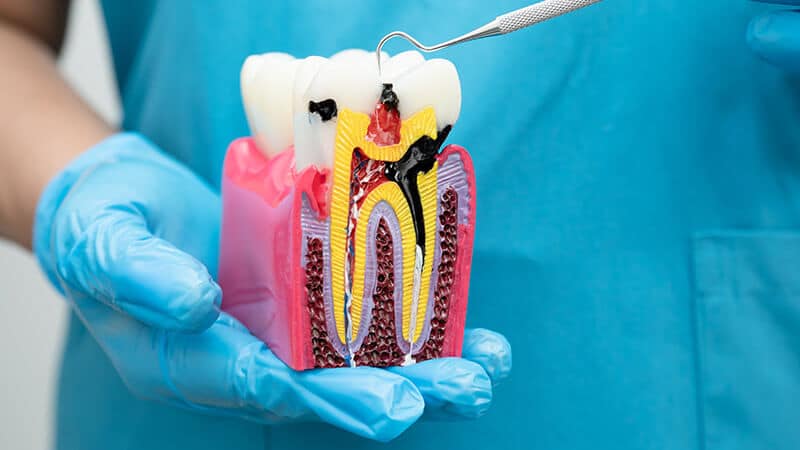Many people feel anxious about the idea of a root canal, mainly due to concerns about pain. However, thanks to modern techniques and anaesthesia, the procedure is generally no more uncomfortable than having a standard filling. In this guide, we’ll walk you through what to expect at every stage of the treatment to help put your mind at ease.
Before the Procedure
Initial consultation
The first step in any root canal treatment is a thorough consultation. During this visit, your dentist will examine the affected tooth and ask about your symptoms, such as pain, sensitivity, or swelling. This helps build a clear picture of the problem and determine whether a root canal is the right course of action.
To confirm the diagnosis, X-rays are usually taken. These images allow the dentist to see the inside of the tooth and the surrounding bone, revealing signs of infection or damage that aren’t visible to the naked eye. It’s a crucial step in planning the treatment properly and ensuring the best possible outcome.
Explanation of the process
Once your dentist has confirmed that a root canal is needed, they’ll explain the procedure in simple, clear terms. You’ll learn what will happen during treatment, how long it’s likely to take, and what kind of results to expect. This is also your chance to discuss any worries or ask about sedation options if you’re feeling nervous.
Pre-treatment instructions
Before your root canal treatment, your dentist may provide some simple instructions to help you prepare:
- Eat a light meal beforehand, especially when local anaesthetic is used.
- Take any regular medications as normal, unless your dentist advises otherwise.
- Let your dentist know about any changes in your health or medication before the appointment.
During the Procedure
Administration of local anaesthetic
At the start of the procedure, your dentist will gently administer a local anaesthetic to numb the area around the affected tooth. This ensures you won’t feel any pain during the treatment, although you may still be aware of some movement or pressure. The numbing effect sets in quickly, allowing the procedure to begin comfortably.
Tooth isolation with a rubber dam
Once the area is numb, your dentist will place a small protective sheet called a rubber dam around the tooth. This keeps the area dry and free from saliva during the procedure, helping to maintain a clean and controlled environment for the treatment.
Cleaning and shaping the canals
After the tooth is isolated, your dentist will create a small opening in the top of the tooth to access the infected or damaged pulp inside. Using delicate instruments, they’ll carefully remove this tissue from the root canals, where bacteria may have built up and caused inflammation or pain.
Once the canals are clear, they are cleaned, disinfected, and shaped to prepare them for filling. This step is crucial to ensure all infection is removed and to create space for a tight, secure seal in the next stage of treatment.
Filling the canals
Once the root canals have been thoroughly cleaned and shaped, they are filled with a rubber-like material called gutta-percha. This seals the canals to prevent bacteria from re-entering and helps protect the tooth from future infection.
Temporary or permanent filling
After the root canals are sealed, your dentist will place either a temporary or permanent filling to close the opening in the tooth. If a crown is needed to strengthen the tooth, a temporary filling is used until the crown can be fitted at a later appointment.
After the Procedure
Numbness and mild discomfort
It’s completely normal to experience some numbness in your mouth for a few hours after the procedure, as the effects of the local anaesthetic wear off. You should avoid eating or drinking anything hot during this time to prevent accidentally biting or burning yourself.
As the numbness fades, you might feel mild soreness or tenderness around the treated tooth and jaw. This is usually temporary and should ease within a couple of days as the area begins to heal.
Pain management
Any post-treatment discomfort is usually mild and can be managed with over-the-counter pain relief, such as ibuprofen or paracetamol. Your dentist may also recommend specific products or dosages to help you stay comfortable during the recovery period.
Follow-up appointment
In many cases, a follow-up appointment is needed to complete the restoration, such as fitting a permanent filling or crown. This final step helps protect the tooth and restore full function, ensuring your root canal treatment lasts for many years.
Long-term care
To keep your treated tooth healthy in the long term, it’s important to maintain good oral hygiene, including regular brushing, flossing, and dental check-ups. With proper care, a tooth that has had a root canal can last just as long as your natural teeth.
Require further advice?
If you believe you may require root canal treatment, you are likely to have further questions about the process. If you are based in London or the South-East and require urgent assistance, give our clinic a call using the details on our contact page. Alternatively, arrange a time to visit one of our root canal specialists by completing our quick and confidential form.



